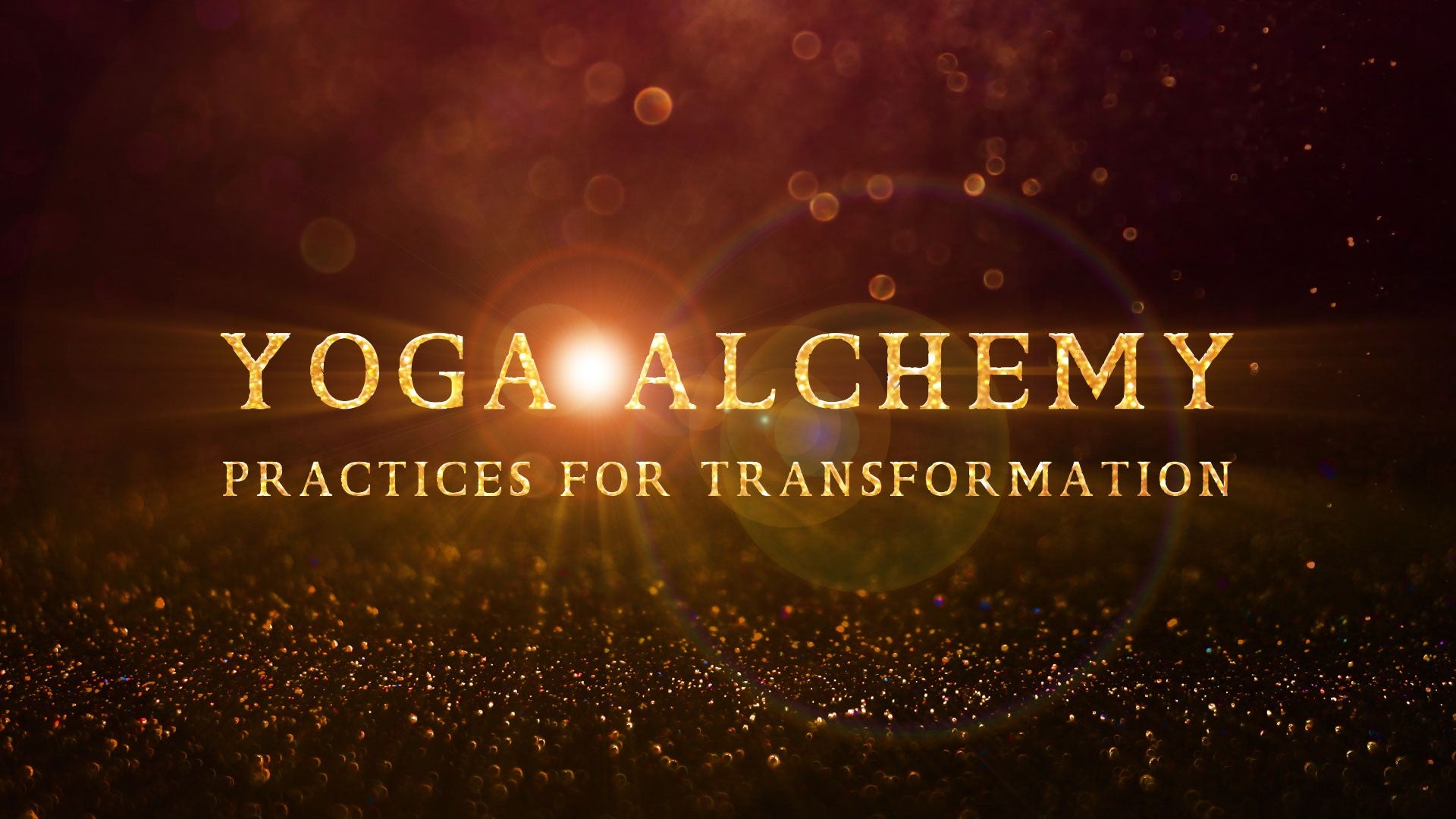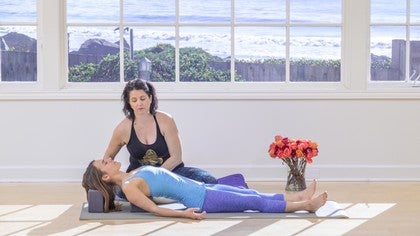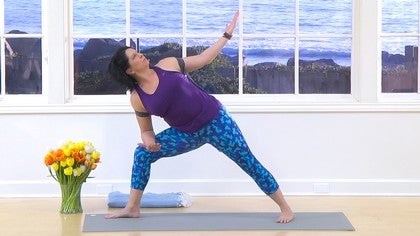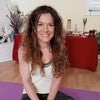Description
About This Video
Transcript
Read Full Transcript
Namaste and welcome to heart bench practice. This is a restoring practice that you can do at the end of your yoga sequences. It's something that you can come home and do after work, even something that you can do in the morning if you're having a really hectic morning. This practice is designed to allow the nervous system to soften while it opens and brings freedom to the chest and to the heart. There are some specifics that we're going to do with it.
I'll show you if you have like a little bit of things going on in your back, I'll show you the adjustments for that, things going on with the neck, Alana's going to help me, she's going to be my model. When you're taking this practice it's so helpful to be in a space where you're not going to have a lot of activity going on. So you don't want to do it in a room where the TV's on or where people are going to be traipsing through. Go off and find a quiet place. I spent one summer with quite a few roommates and I actually practiced in my bathroom because I could be by myself.
I just shut the door, put my yoga mat down and do my restorative postures. So there's always an option if you want to try something like that. But go ahead and give yourself that time. Give yourself that time, that sweetness to spend letting the body fully restore. So I'm going to hop out of the way.
I've laid my blocks out to show you. Now you really do want to have some yoga blocks. You can do this with books, I've done it actually with books, but it's much easier if you just get two blocks that are up the same types of blocks. There's three different heights to a yoga block. There's the low, the medium, and the high.
We're going to work with the low and the medium, just like this. Now what's going to happen is this is where Alana's head's going to be and this is where her back is going to be. And her shoulder blades, if this was a shoulder blade, is going to be half on the block and half suspended between the two blocks. What that does is it gives a really nice support, gives a shelf to the heart. And when the heart is supported in that way, it allows it to have a lot of release and space across the body.
You will feel that. It's really amazing. Oh, it makes you relax so deeply. So I'm going to ask Alana to come over and she's going to place herself on the blocks. And at first, if it's the first time you've ever done this, it's kind of hard to figure out like, where are my shoulder blades and what is half on my shoulder blades?
So I'm going to show you what it looks like when it's correct, what it looks like when it's not, and then I'm going to talk you into it. So if you can just watch for just a moment. So right now, Alana's got half of her shoulder blades on and half off. It's perfect. Lift your chest for me.
This is what it would look like if all the shoulder blades were supported. And what happens is the shoulder blade still stays at an angle and it's not very comfortable, is it? Not as comfortable. So she's going to lift again. I'm going to slide back and we're going to see, is that the sweet spot?
There's a sweet spot. Now occasionally, if you have a lot of tightness in the shoulders, one of the things that happens is your head will actually be cranked up the other way, like that. And there's really nothing that you can do about that. Like if your head does that, you just have to put more height under it. Just like that.
And what that will do is it will help to alleviate the pressure of the neck swinging back. When you're in a back bend like that, it makes the nervous system kind of agitated. You're telling it, let's go into a back bend now. But really what you're trying to do is you're trying to get quiet. You're not trying to get active.
You're not going into an active back bend. I'm going to take this out because Alana doesn't need it. Now the other thing is that sometimes the blocks are too, they're too high even at the lowest setting for people. And that causes achiness in the mid back, sometimes the upper back and sometimes the low back. So the best way to adjust for that is just to have them lift their pelvis up and you slide a blanket under there, just like that.
That's easy for you to do if you have a blanket next to you, just slide it right under there. And then if you want to straighten your legs, you can straighten your legs. If you want to keep them bent, you can keep them bent. It's really up to you. Usually if you're elevated on a blanket, you'll find that over time it's more comfortable to have the legs bent.
So bend your legs. I'm just going to remove this because it'd be better for you the other way. There we go. So she's going to relax here and straighten her legs or not. It's up to her.
And I'm going to talk you into this posture. So go ahead and place your blocks and you can see how much space is in between these two blocks. It's quite a bit of space, almost so blocks with sometimes a little bit more. So place your blocks so that the block under the head is at the medium height and the block that's going to be under the shoulder blades is at the low height. There's space between maybe eight inches, depending on your height.
The taller you are, a little more space you'll need. Arrange yourself on your mat and go ahead and lower back onto the block. The taller block is under your head. The other block is underneath the shoulder blades, but only bottom half. Now from here, there's this little wiggle thing that you do.
You lay there for a minute and say, huh, I wonder if this is it. Wiggle a little towards your head. Rest there for a minute. How does that feel? Wiggle a little more the other way maybe.
Wiggle around. There is a sweet spot. If you just lay down in it and go, okay, this is the pose, you may not be in your sweet spot and you want to find that spot. It's easy as a teacher to see if it's there or not because I can look at the person's face and you can see that Alana is really digging it. So get on cozy and comfortable.
Make sure you're warm. Make sure your environment is as quiet as you can get it. Once you get settled in, you're going to take a few breaths in the posture. Now initially it may feel fine, but as you rest and breathe in this first couple of minutes, you might discover that it starts to be uncomfortable in places. There's some things that you can do about that.
Since we are working with the nervous system and we're working with bringing your system to a state of ease, this really isn't a pose that I suggest you use to open your chest more. Don't use it as an active posture, even in a restorative setting. It can be used that way, don't get me wrong, but for the purpose of this particular practice, I'm wanting to help you unwind your nervous system. So those sensations of the body really opening are not helpful. It's sending you into your sympathetic nervous system, kind of the one where you're getting real attentive, fight or flight, and out of your restorative aspect of the nervous system, the parasympathetic.
So if you feel uncomfortable already, it means you probably need a little height under your pelvis. So go ahead and just put a little bit of height under your pelvis. Use a little bit of a block. Again you could use a book if you want. Even if you want to straighten your legs or you want to keep them bent.
And then begin to let your body be received by the props. So initially with props, we sort of hold back a little bit with props, it's like we're, it's almost like we're trying to help the props. Don't do that here. Like really let yourself relax. Go with each exhalation, the body melts a little bit more into the floor, into the blocks.
Maybe you're using blankets too, into the blankets. There may be sounds around you, there may be sounds outside. I'd like for you to use those sounds as a part of life. So don't resist the sounds that are happening. Relax and let them just be a part of your life right now.
The resistance actually causes the difficulty. So you're feeling the bones relax, you're feeling the eyes soften behind your closed lids, the jaw goes slack. There's even a sense that your brain starts to relax and rest on the back part of the skull. You may notice that your breath has grown shallow, this is perfect, it should be. The more still we become, the less oxygen we need.
This is not a posture to develop our lung capacity, this is a posture to unwind our nervous system. Now beginning with the relaxation of the eyes, feel as though the sinuses also relax down, like they melt. The jaw, the hinge of the jaw softens and as it softens, it feels like it's melting down too. Even the tongue is resting in the mouth. The throat is quiet and the chest is so beautifully supported.
You allow the chest to just melt away. You feel it growing deeper and it's almost like it also spills off the shoulders. There is a very simple feeling in the body, an unraveling of sorts. The weight of the pelvis is helping to create a little traction to the spine. There is an amazing heaviness in the legs.
Everything is in a state of this quiet descending, this quiet surrender all the way down to the feet. The arms are heavy, spilling out of the body, relaxing all the way to the fingertips. Om tade, tu tade, tu rei soha. Om tade, tu tade, tu rei soha. Om tade, tu tade, tu rei soha.
Om tade, tu tade, tu rei soha. Om tade, tu rei soha. Om mamantare. Om tade, tade. Om tade, tade.
Om tade, om tade. If you feel like you would like to remain in this posture, remain. If you fall asleep, don't fret, no more healing is getting done. If you're ready to come out, then you allow the body to move in a way that feels natural to you. Usually that involves the hands, maybe the feet.
You bend the legs, you're perched up on your blocks, remember. So when you roll to your right side, just be aware that you're going to be traveling some space as you roll to your side. Rest on your side for just a moment. Let everything relax again, just as though you were still on the blocks. And then very gently, letting your head be the last thing that rises, you're going to press yourself up slowly, come to sitting.
So this practice is very healing. It's wonderful if you have anything going on with the physical heart, with what I call the mental heart and the emotional heart. So practice well, thank you for joining us. Peace out, namaste.
Yoga Alchemy
Comments
You need to be a subscriber to post a comment.
Please Log In or Create an Account to start your free trial.













